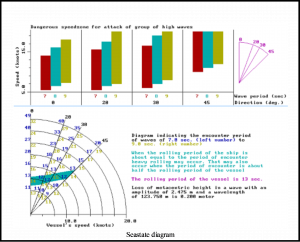LOCOPIAS module: Following seas
High quartering and following seas may inflict immediate danger to a vessel.
Those dangers can be categorized as follows:
- Surfriding: when the speed of the vessel approximates the speed of the waves, the vessel will be accelerated by those waves, thus reducing the rudder function. This effect may cause broaching;
- Loss of stability on a wave crest: for a vessel with V-shaped cross sections the waterline breadths at the vessel’s ends is reduced in the wave troughs, which reduces G’M, and may even lead to negative G’M values;
- Synchronal rolling or resonance;
- Asynchronal rolling or resonance;
- In order to be able to assess those dangers, LOCOPIAS can be equipped with a specialistic function, which is based on the method of IMO paper SLF 39/3/3. This LOCOPIAS function presents a graph, which indicates all possible dangers instantaneously. It contains three elements;
- A bar chart, indicating the dangerous speed zone for surf riding;
- A polar diagram, which indicates dangerous resonance zones for different courses and speeds. In this diagram the areas with possible synchronous or asynchronous resonance (resulting from the actual loading condition) are indicated in red;
- An indication of the loss of stability, by showing the loss of metacentric height on a wave crest with a height of 2% of the length between perpendiculars.
LOCOPIAS produces a graph, of which an example is presented below, which can help the crew to determine a possible change of course or speed.


